How to Understand Requirements Strategies in SAP ERP and APO
Executive Summary
- Requirement Strategies are set in APO and control how a product’s forecast is consumed, if a requirement is produced or not produced, and if an availability check is performed.

Introduction
Requirements strategies control consumption and control other aspects of APO. You will learn the components that make up the Requirement strategies and configure them and use them to best effect.
What are Requirements Strategies?
Requirements strategies do some things in APO. Their configuration setup seems designed to be maximally confusing. However, once boiled down to their basics, requirements strategies are pretty simple. Requirements strategies are of primary importance to SNP and PP/DS and the corresponding linkages in ERP and have a light connection to GATP. The graphic below shows the major control areas for requirement strategies.
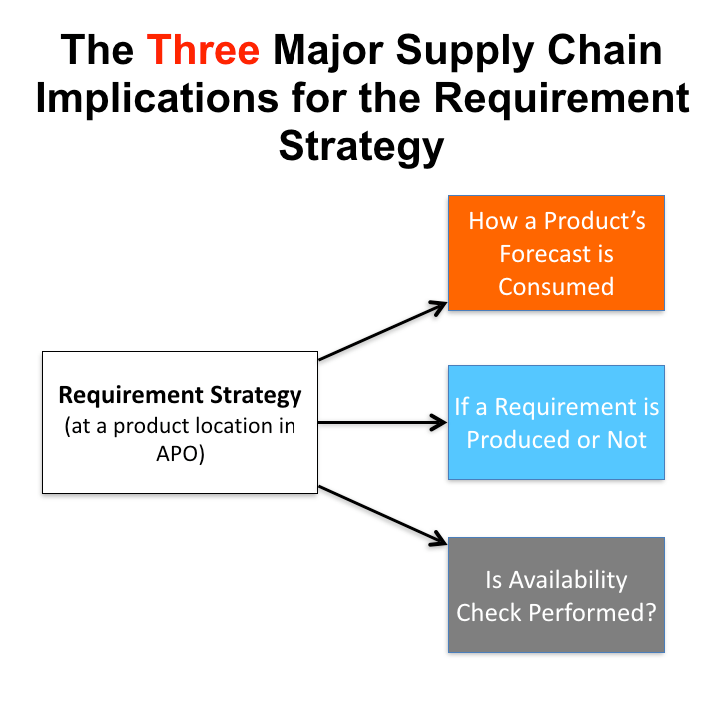
The requirements strategy is defined by SAP as:
“Determines how production quantities are planned in SAP APO and how the forecast is consumed by other orders. The purpose of consumption is to ensure that requirements are not duplicated in the system and that the most detailed requirements are used. Forecasts and sales orders are for instance both requirements. Since a forecast is less specific than a sales order, it is reduced when other more specific requirements, such as sales orders, exist for the same product. In this way if both forecasts and sales orders are used to generate receipt elements, for example planned orders, the correct quantity is always generated. Consumption takes place in order liveCache. This means that the forecast is not consumed in Demand Planning.” – SAP Help
The requirements strategies that I will show in APO are all defined in SAP ERP. They are assigned to product location combinations in SAP ERP with the MRP Group. They then automatically populate the Product Location Master in APO.
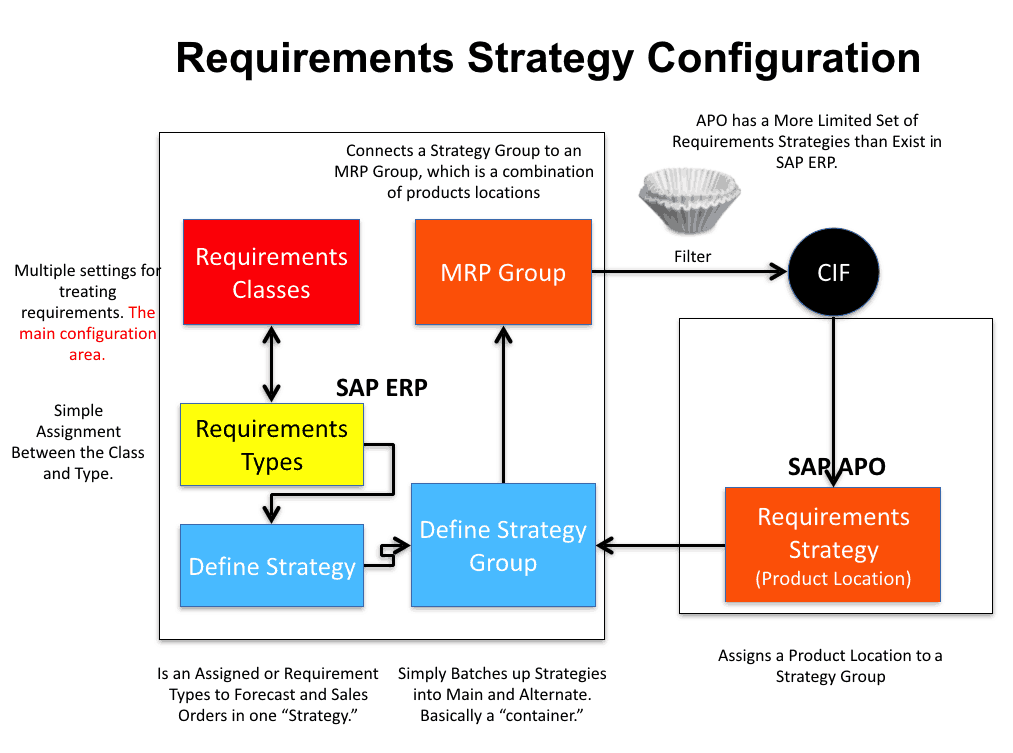
The configuration is a bit of a Matryoshka doll, but most of the configuration “action” is in the Requirements Classes, the first configuration objects setup. The rests are either standard containers or grouping objects. One of the most interesting features of the requirement strategies is that there are more in ERP than in APO.
The Requirements Class
This is the most important configuration object for the Requirements Strategies and is the foundational object on which the other objects are based. There are many settings on this screen, but the most relevant fields for our purposes are in the upper left-hand corner, surrounded by a yellow box.
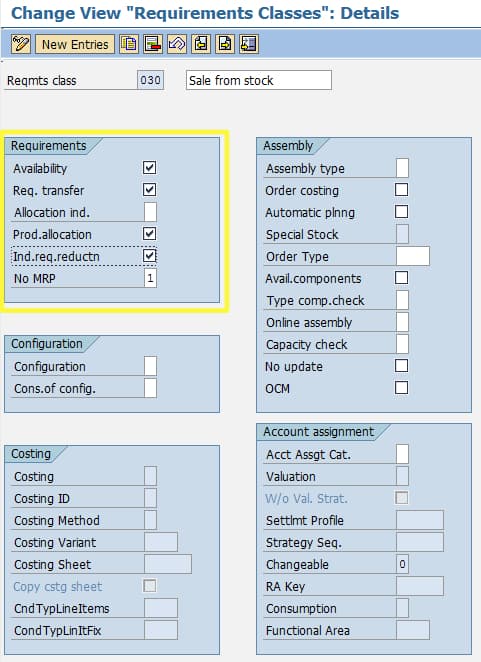
Remember, this is all in SAP ERP presently.
- Availability: This determines if availability checking is performed. It applies for SD if only ERP is in scope, and I believe used by GATP.
- Req Transfer: Determines if the transfer of requirements occurs.
- Allocation Indicator: Controls the consumption of customer requirements from the forecast. This is one of the major controls in this overall configuration. Consumption can be enabled or disabled, which appears in the planning book right here.
- Product Allocation: Whether product allocation is active.
- Ind.req.recution: Determines anonymous make to stock production reduced by customer requirements, which are planned as a sale from stock.
- No MRP: Whether requirements are relevant for the planning run. (Can be left on even if MRP is not run in ERP, as the control for things like whether a product is on reorder point or included in a planning run is set in the profiles for the SNP Heuristic, optimizer, or CTM)
The Requirements Types
A simple mapping configuration object. The requirements class is the third column over, and this is connected to the requirements type. This allows multiple requirement types to be connected to multiple requirement classes.
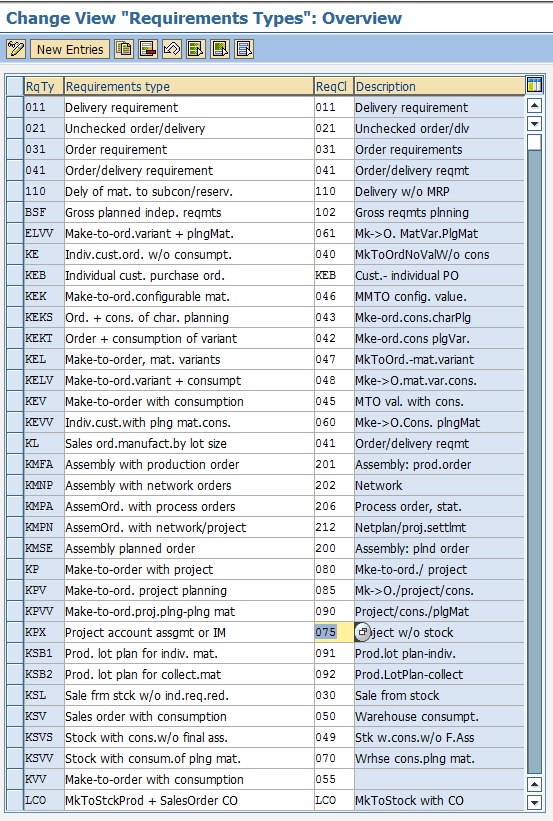
The Requirements Strategy Definition
This is where the Requirements Strategy is defined and where it is assigned to the Requirements Type.
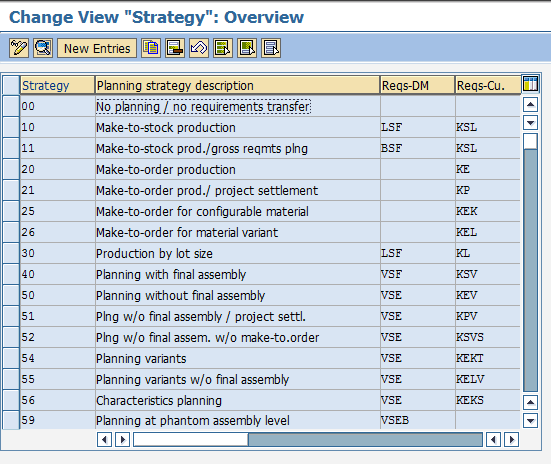
However, you can’t tell by looking at this screen. The column below “Reqs-DM” is misnamed and should be called “Req-Type.” This is apparent if you hit the drop down on any item in this column, the different Requirements Types will come up.
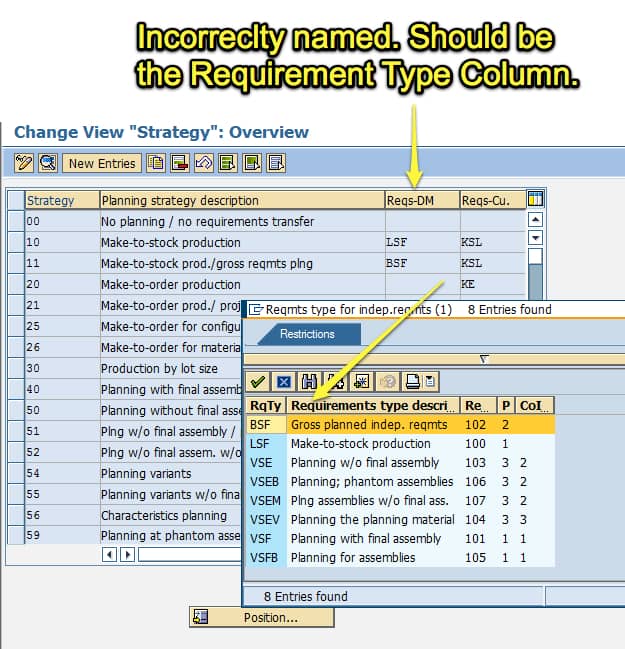
The Strategy Group
This is where multiple Strategies can be assigned to Strategy Groups — which end up just being the “Requirement Strategy.” In some cases, there are multiple Requirement Strategies assigned to a Strategy Group, but in most cases, there are not. So the relationship between the Strategy and the Strategy Group is one-to-one. This is just another container in most cases. In fact, it is not clear to me why I would want to configure multiple strategies per group.
This is shown in the screenshot below for Make to Stock Production.
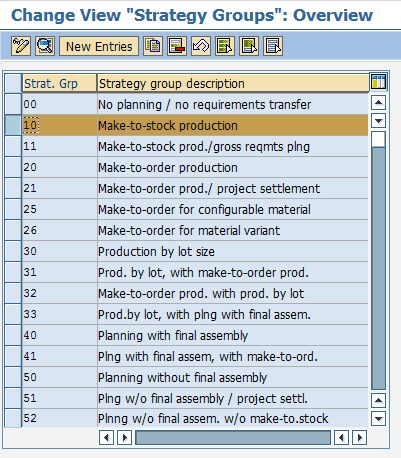
The next screen is if we select the Make to Stock Production item.

Where are the Requirements Strategy Set in APO?
This is CIFed over to APO, and this screenshot below shows the requirement strategies that come up in the Product Location Master in APO. APO can represent fewer requirement strategies than SAP ERP.
Standard Types of Requirement Strategies and Understanding What They Are
These are the standard types that ship with SAP. However, they are just associations of fields that are combined to make one requirement strategy group. Reading too much into the description is more confusing than enlightening.
- “10 Anonymous Make-to Stock Production: In this strategy, no consumption takes place. The planned independent requirements are reduced when the goods issue is posted in SAP R/3.
- 20 Planning with Final Assembly. This is the normal case. Sales orders consume planned independent requirements. No special planning segment is used.
- 30 Planning without Final Assembly: Use this strategy for an assemble-to-order scenario. The final product is not critical for planning; the component assemblies, however, are. An example is the assembly of PCs. Sales orders are received for assembled PCs, but the components such as hard disks; CPUs, and graphic boards
- 40 Planning Product: In this scenario, you use a dummy product to plan demand. A sales order for real products consume the planned independent requirements of the dummy product. For more details, see Planning Product.” –SAP Help
This is controlled by the requirements strategy sub-tab of the Demand tab in the location product master. However, as described in the configuration object relationship diagram shown above, these should automatically come across the CIF.
Requirements Strategies and the Planning Book
As discussed, one of the most important features of Requirements Strategies is how it controls forecast consumption. Of the different options, “20,” Planning w/ Final Assembly seems like the closest to most companies I have worked with. When 20 is selected, the consumption in the planning book looks like the following:
Requirement Strategies as Customized in APO
Interestingly, these Requirements Strategies can be entirely developed inside of APO.
They consist of six fields. The relevant fields are bolded and orange.
- Description: Essentially, the name and description.
- Category: The Stock/Receipt/Requirement/Forecast Category is part of the requirements strategy. Only those processed outside of the supply network (i.e.,.VMI, Third Party Order Processing) have a category other than forecast in this field.
- PIR Segment: This is the field that specifies the segment in which you want the system to create the planned independent requirement. This is a quite involved setting, and I have SAP’s definition listed after these bullet points.
- Assignment Mode: Determines how sales orders consume the forecast. Only one type of consumption is possible for each requirements strategy.
- Category Group: “In forecast consumption, you use the category group to determine which kind of orders, for example, sales orders or planned orders, can consume the forecast. – SAP Help. “This is simply the demand element. It would be more logical if this field were only named “demand.”
- Planning Version: Obviously, which planning version this requirement strategy applies to.
Now we can get into the PIR Segment options.
Net Segment
With this option, the system creates planned independent requirements in the net segment. Requirements for sales orders are also generated in the net segment. Consequently, the sales orders can consume the planned independent requirements. Planned orders can be converted to production orders for the finished product. Choose this planned independent requirement segment if you are using make-to-stock production (requirement strategy 10, for example) or planning with final assembly (requirement strategy 20, for example).
Planning without Final Assembly, with Individual Requirements
With this option, the system creates planned independent requirements in the planning segment. Requirements for sales orders are generated in the individual customer segment. Consequently, the sales orders can consume the planned independent requirements (forecast).
- Planned orders cannot be converted to production orders for the finished product.
- The planned orders are used to generate dependent requirements for the components, which can then be procured before the sales order is created. Choose this planned independent requirements segment if you are using make-to-order production (requirement strategy 30, for example).
Planning without Final Assembly, without Individual Requirements
With this option, the system creates planned independent requirements in the planning segment. However, requirements for sales orders are generated in the net segment. Choose this planned independent requirement segment if you create your requirement strategy for planning without final assembly and without make-to-order production (this is equivalent to strategy 52 in SAP ERP).
This type of strategy enables you to use a forecast as a basis for procuring components. Stock at the finished product level is not taken into account for production. The finished product is not produced until the sales order is received. There is no standard requirements strategy in SAP APO that uses this planned independent requirements segment.
Characteristics-Based Planning without Final Assembly
“This segment is similar to the segment Planning without final assembly, with individual requirements. However, choose this planned independent requirements segment only if you are planning with configurable products relevant for variant configuration (requirements strategy 35, for example).” – SAP Help
I am currently creating a custom Requirements Strategy, which I will be testing shortly. However, creating a custom Requirements Strategy is not necessary, and we can obtain the outcome desired by entering no requirements strategy.
The best way to think of this is that the system uses the larger of the two (sales or forecast) as its Total Demand in default mode. SAP’s descriptions of each of these combinations are not clear. For this reason, I have translated the SAP English into what I think the correct definitions should be.
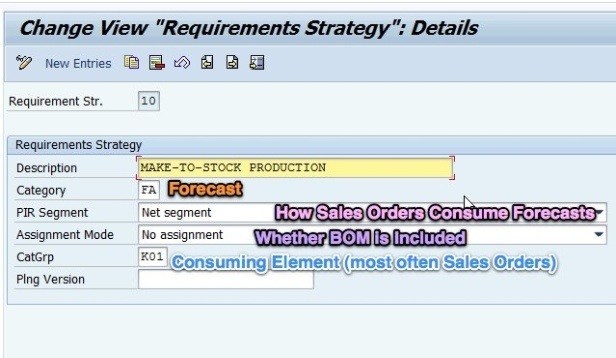
A requirements strategy is just a combination of PIR Segment, Assignment Mode, Category Group, and Planning Version. When these different selections are combined above, it is called “Make to Stock.” As stated, all Requirements Strategies are simply a combination of settings.
The Assignment Mode
According to SAP Assignment Mode is the following:
“The assignment mode determines how sales orders consume the forecast, and whether final assembly is taken into account. It corresponds to the allocation indicator in SAP R/3. This indicator is assigned to the sales order via the requirements class.” – SAP Help
These are the options:
- No assignment
- Assign customer requirements to planning with assembly
- Assign customer requirements to planning without assembly
- Assign customer requirements to planning product
Creating A Custom Requirement Strategy in APO and Assigning to a Product Location Combination
APO Requirement strategies control important features of planning, such as how the forecast is consumed and what demand consumes the forecast, and when planned independent requirements are created. A full explanation of how requirement strategies are set up is explained in this article. However, in this article, I would like to describe how custom requirement strategies can be set up in SAP APO.
Requirement strategies can be found from the path below:
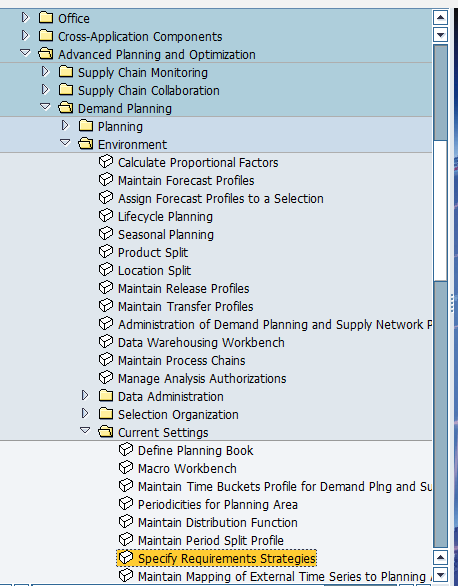
Once you select this, you will be taken to this screen, which shows all requirement strategies currently set up in APO.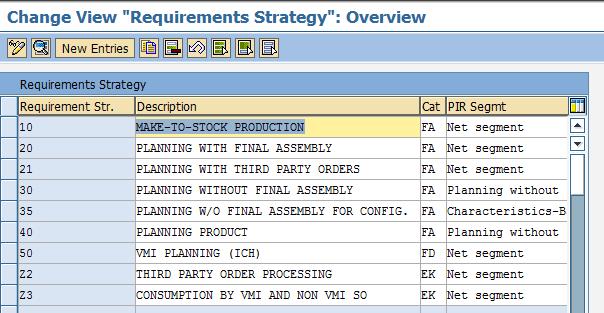
Actually, all field settings are available on this screen, but they can’t be seen without scrolling. However, selecting one will bring up the following screen.
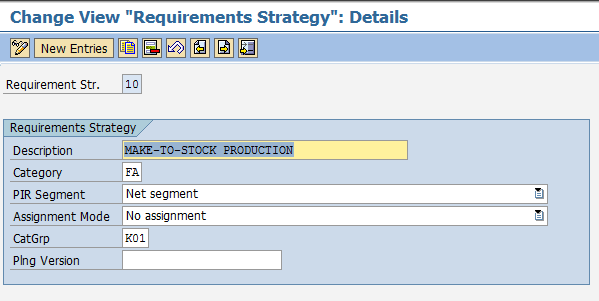 Here the fields can be changed, and a new requirements strategy created.
Here the fields can be changed, and a new requirements strategy created.
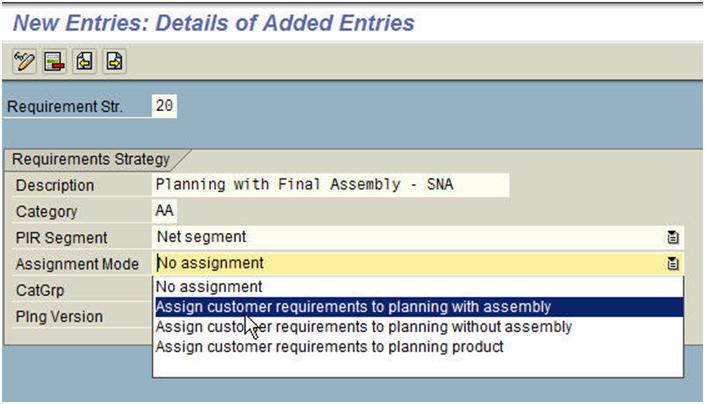 Next, a Category Group, which was previously created in this article.
Next, a Category Group, which was previously created in this article.
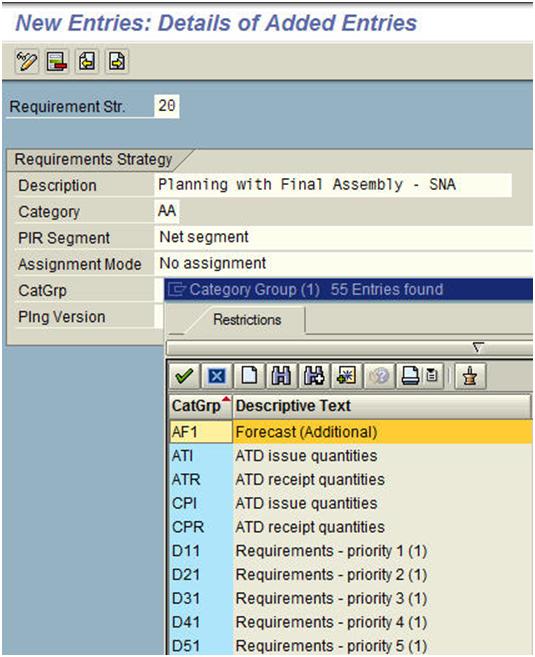 We then need to assign a Planning Version.
We then need to assign a Planning Version.
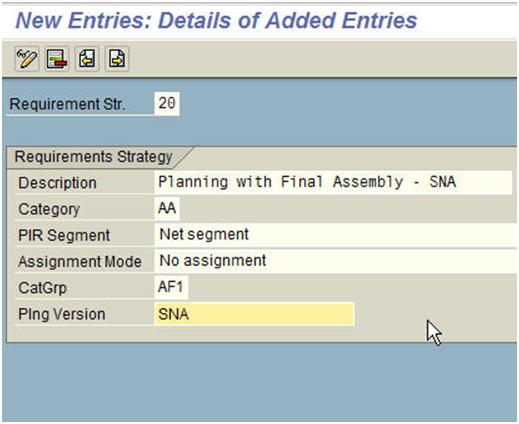
However, when we try to save this, we find that we cannot. We forgot that there could only be one Requirements Strategy. And 20 is already a standard one. So we change ours to 75.
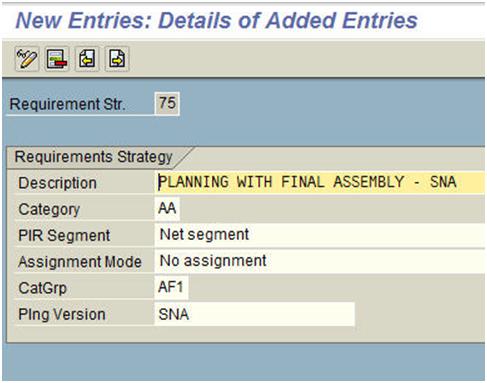
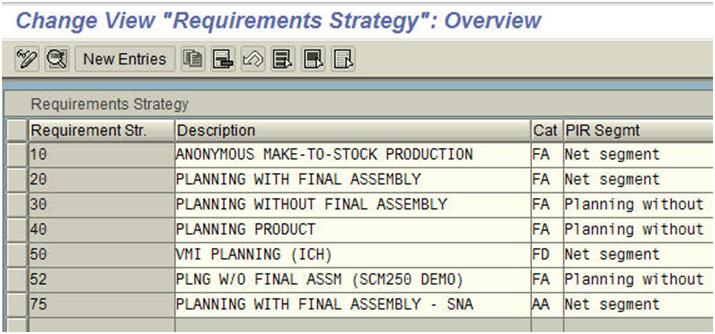
After the strategies are defined, they are applied per product location.
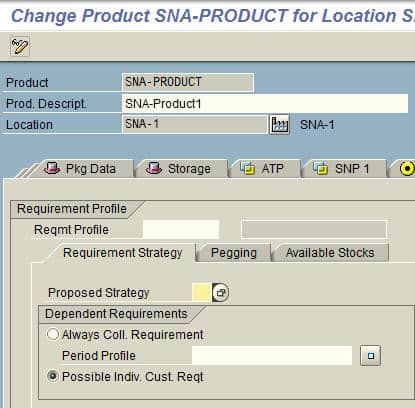
Now we will select the strategy that we just created (SNA)
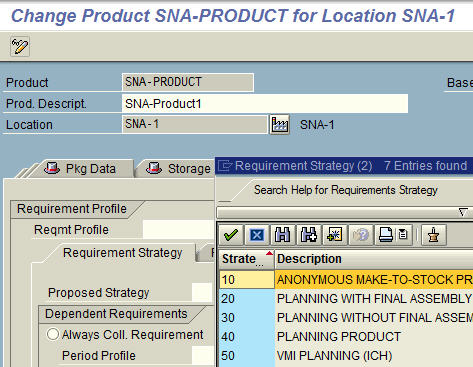
Strategies for Planning Components in SAP ERP
The planning strategies discussed in this section address planning the procurement (production or purchase) of components by planning the components themselves. They are particularly appropriate when there are different finished products, possibly with an irregular requirement pattern where planning is not possible). At this level, the requirements can be consolidated and smoothed. Using these strategies for planning components is also favorable if the finished products are consumption-based. The overall goal of planning at the component level is to procure components to stock even without sales orders so that you can react to customer requirements as quickly as possible. Choose a strategy for planning components if the components are not directly linked to specific sales orders or if costs should be monitored at the component (material) level and not at the order level.
Planning at Assembly Level (70)
“This planning strategy is useful if you can make a safe forecast for specific assemblies rather than for a variety of finished products. As described for strategy 40, with this strategy you need to maintain the master data for the assembly. In the SAP menu, navigate to the MRP 3 tab via Logistics Production • Master data • Material master • Material • Change • Maintain immediately. On the MRP 3 tab, in the Strategy group field, enter the number 70. On the MRP 3 tab, set the Mixed MRP flag to a value of 1. Specify the consumption parameters consumption mode, Fwd consumption per., Fwd consumption per.) to enable the consumption of primary requirements by incoming sales orders. If you implement this strategy in a make-to-stock environment, you must set the Individual/coll, flag on the MRP 4 tab to a value of 2.” – SAP Help
Planning at Phantom Assembly Level
“This strategy can be used for a number of components with the following characteristics: the components are always assembled to form specific finished products, they should be planned together, or they are not a “real” assembly, but only a “phantom” assembly. As described for strategy 40, with this strategy you need to maintain the master data for the phantom assembly. In the SAP menu, navigate to the MRP 3 tab v Logistics • Production • Master data • Material master • Material • Change Maintain immediately. On the MRP 3 tab, in the Strategy group field, enter the number 59. On the MRP 3 tab, set the Mixed MRP flag to a value of 1. ?. specify the consumption par •parameters (Consumption mode Fwd consumption per., Fwd consumption per.) to enable the consumption of primary requirements by incoming sales orders. If you implement this strategy in a make-to-stock environment, you must set the Individual/coll, flag on the MRP 41 MRP 4 tab to a value of 2.” – SAP Help
The book Inventory Optimization in SAP has some interesting things to say about requirement strategies. I have some of these quotes listed below:
Strategies for Make-to-Order Production in SAP ERP
“The planning strategies described in this section are designed for the production of a material for a specific sales order. Finished products are not produced until a sales order is received. Therefore, make-to-order strategies always support a very tight customer-supplier relationship because the sales orders are tightly linked to production. The same relationship exists between the sales order and production in a make-to-order environment. Make-to-order production can be implemented in production with variant configuration or in assemble-to-order production. Choose a make-to-order strategy if the materials are clearly assigned to specific sales orders need to De monitored at the sales order level and not at the material level. Planned goods receipts (like returns) usually cannot be used for other sales orders (even if they occur in the correct processing order), unless they are adapted le customer’s needs. The planning strategies discussed in this section presume that you want to plan the procurement (production or purchase) to your components by planning the finished products. This means there should be a relatively steady demand for your finished product.)” – Inventory Optimization with SAP
Integration with SAP ERP
This is an important point of integration between SCM and ERP.
This is because, in the absence of SCM, SAP ERP will plan with these strategies. However, if SCM is enabled, the way the requirement strategies are set up in SAP ERP must be changed so that the two are in synch. They can be configured for SCM in the IMG here.
References
https://help.sap.com/saphelpscm50/helpdata/EN/61/95613b3e24526fe10000000a11402f/content.htm
https://help.sap.com/saphelpscm50/helpdata/en/e6/28dadc939241469dd64f0eb925f328/content.htm